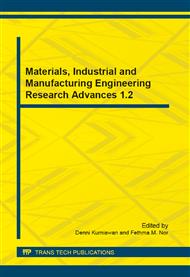[1]
V. Lughi, V. Sergo, Low temperature degradation-aging- of zirconia: A critical review of the relevant aspects in dentistry, Dental Materials Journal. 26 (2010) 807-820.
DOI: 10.1016/j.dental.2010.04.006
Google Scholar
[2]
S. Lawson, Environmental Degradation of Zirconia Ceramics, Journal of European Ceramic Society. 15 (1995) 485-502.
DOI: 10.1016/0955-2219(95)00035-s
Google Scholar
[3]
J.J. Swab, Low Temperature Degradation of Y-TZP Materials, Journal of Materials Science. 26 (24) (1991) 6706-6714.
DOI: 10.1007/bf02402664
Google Scholar
[4]
S. Ramesh, J. Purbolaksono, M. Hamdi, I. Sopyan, R. Tolouei, M. Amiriyan, F. Tarlochan, W.D. Teng, Low-temperature degradation (LTD) behaviour of CuO-Doped tetragonal zirconia ceramic, Ceramics-Silikáty. 56 (2012) 15-19.
DOI: 10.1166/asl.2012.3937
Google Scholar
[5]
J. Chevalier, S. Deville, E. Munch, R. Jullian, F. Lair, Critical effect of cubic phase on aging in 3 mol% yttria-stabilized zirconia ceramics for hip replacement prosthesis, Biomaterials. 25 (2004) 5539–5545.
DOI: 10.1016/j.biomaterials.2004.01.002
Google Scholar
[6]
M. Yoshimura, T. Noma, K. Kawabata, S. Somiya, Role of water on the degradation process of Y-TZP, Journal of Material Science Letters. 6 (1987) 465-467.
Google Scholar
[7]
J. Chevalier, L. Gremillard, A.V. Virkar, D.R. Clarke, The tetragonal–monoclinic transformation in zirconia: lessons learned and future trends, J Am Ceram Soc. 92 (2009) 1901–20.
DOI: 10.1111/j.1551-2916.2009.03278.x
Google Scholar
[8]
P. Kohorst, L. Borchers, J. Strempel, M. Stiesch, T. Hassel, F.W. Bach, C. Hubsch, Low-temperature degradation of different zirconia ceramics for dental applications, Acta Biomaterialia. 8 (2012) 1213–1220.
DOI: 10.1016/j.actbio.2011.11.016
Google Scholar
[9]
T.F. Alghazzawi, J. Lemons, P.R. Liu, M.E. Essig, A.A. Bartolucci, G.M. Janowski, Influence of Low-Temperature Environmental Exposure on the Mechanical Properties and Structural Stability of Dental Zirconia, Journal of Prosthodontics. 21 (2012).
DOI: 10.1111/j.1532-849x.2011.00838.x
Google Scholar
[10]
S Janyavula, N. Lawson, D. Cakir, P. Beck, L.C. Ramp, J.O. Burgess, The wear of polished and glazed zirconia against enamel, The Journal of Prosthetic Dentistry. 109 (2013) 22-29.
DOI: 10.1016/s0022-3913(13)60005-0
Google Scholar
[11]
D.F. Brian, A. Dirk, AM. LIoyd, J.R. Ariel, Accelerated aging characteristics of three yttria-stabilized tetragonal zirconia polycrystalline dental materials, J Prosthet Dent. 108 (2012) 223-30.
DOI: 10.1016/s0022-3913(12)60166-8
Google Scholar
[12]
J.F. Dennis, Zirconia Restorations: Perception or Evidence? Inside Dentistry Journal. 6 (2010) 81-84.
Google Scholar


